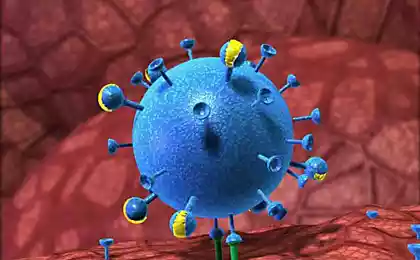286
What will help stop the spread of the virus
Recently, there has been a lot of talk about what herd immunity is . Experts see it as an opportunity to cope with the pandemic. But is it really so? Today the editors will try to figure out an important issue. In this article, we will explain how herd immunity works in society and how it can be achieved.

Collective immunity Collective immunity is the special resistance of people in society to pathogens. And the more immunity a person has, the less likely the virus is to spread. By the way, thanks to this, the virus bypasses those who cannot be vaccinated. For example, babies, pregnant women, or people with weakened immune systems.

GettyImages Ways of Achievement Vaccination is the most logical and safest way to achieve herd immunity. But the development and implementation of a vaccine is an incredibly long and resource-intensive process. Therefore, so far we are unwittingly following the second path, when a significant part of the population develops antibodies to pathogens. This happens naturally after recovery.

GettyImages Unfortunately, the second method does not guarantee a successful result. First, the coronavirus claims hundreds of lives every day across the planet. Not everyone can just get sick. Secondly, it has long been proven that the antibodies produced will not live forever. Already in our time, cases have been recorded when the same person fell ill with coronavirus several times.
For herd immunity to perform its function, it must be at a consistently high level. Therefore, it is imperative that as many people as possible get vaccinated. Among other things, there is a threshold for achieving herd immunity. It depends on the disease and the reproductive number of the virus.

GettyImages It shows how many people can get sick if they come into contact with a sick person. Accordingly, the more serious the virus, the higher its reproductive number and the higher the threshold for achieving immunity in society. For example, the reproductive number of measles is approximately 12-18. To achieve collective immunity to this disease, it is necessary to vaccinate up to 94% of the population.
Threshold for Achieving Herd Immunity The threshold for achieving herd immunity from COVID-19 is not precisely known. Scientists are constantly supplementing the already acquired knowledge about it. So far, it is clear that the reproductive number of the virus ranges from 2 to 3.2. At this level, 50–67% of the population with developed immunity is sufficient.

GettyImages If we focus on real numbers, then, for example, in the United States 60% of the population will be 198 million people. Will all these people be able to get sick without consequences? Hardly. In this case, the mortality rate will approach at least 1 million people.
Real case The Brazilian city of Manaus experienced a severe coronavirus outbreak in May this year. In a short period of time, about 4 thousand people died, most of whom were young people. At the peak, from 44 to 52% of the population were simultaneously sick. Experts are sure that at that moment a total of 66% of people were ill.
After that, new cases of the disease became less and less. Therefore, the researchers concluded that the city most likely achieved herd immunity. However, the situation is now starting to deteriorate again. It only means that the herd immunity achieved in this way is short-lived.

GettyImages Well, it looks like we just have to wait for the introduction of a proven vaccine . Until then, all we can do is be socially responsible. Don't forget about personal protective equipment and social distancing in public places. Take care of your personal hygiene and remember that the virus has not disappeared anywhere. In many countries, the healthcare sector is already on the verge of collapse. Be vigilant and take care of yourself!
Photo on the preview and in the article.

Collective immunity Collective immunity is the special resistance of people in society to pathogens. And the more immunity a person has, the less likely the virus is to spread. By the way, thanks to this, the virus bypasses those who cannot be vaccinated. For example, babies, pregnant women, or people with weakened immune systems.

GettyImages Ways of Achievement Vaccination is the most logical and safest way to achieve herd immunity. But the development and implementation of a vaccine is an incredibly long and resource-intensive process. Therefore, so far we are unwittingly following the second path, when a significant part of the population develops antibodies to pathogens. This happens naturally after recovery.

GettyImages Unfortunately, the second method does not guarantee a successful result. First, the coronavirus claims hundreds of lives every day across the planet. Not everyone can just get sick. Secondly, it has long been proven that the antibodies produced will not live forever. Already in our time, cases have been recorded when the same person fell ill with coronavirus several times.
For herd immunity to perform its function, it must be at a consistently high level. Therefore, it is imperative that as many people as possible get vaccinated. Among other things, there is a threshold for achieving herd immunity. It depends on the disease and the reproductive number of the virus.

GettyImages It shows how many people can get sick if they come into contact with a sick person. Accordingly, the more serious the virus, the higher its reproductive number and the higher the threshold for achieving immunity in society. For example, the reproductive number of measles is approximately 12-18. To achieve collective immunity to this disease, it is necessary to vaccinate up to 94% of the population.
Threshold for Achieving Herd Immunity The threshold for achieving herd immunity from COVID-19 is not precisely known. Scientists are constantly supplementing the already acquired knowledge about it. So far, it is clear that the reproductive number of the virus ranges from 2 to 3.2. At this level, 50–67% of the population with developed immunity is sufficient.

GettyImages If we focus on real numbers, then, for example, in the United States 60% of the population will be 198 million people. Will all these people be able to get sick without consequences? Hardly. In this case, the mortality rate will approach at least 1 million people.
Real case The Brazilian city of Manaus experienced a severe coronavirus outbreak in May this year. In a short period of time, about 4 thousand people died, most of whom were young people. At the peak, from 44 to 52% of the population were simultaneously sick. Experts are sure that at that moment a total of 66% of people were ill.
After that, new cases of the disease became less and less. Therefore, the researchers concluded that the city most likely achieved herd immunity. However, the situation is now starting to deteriorate again. It only means that the herd immunity achieved in this way is short-lived.

GettyImages Well, it looks like we just have to wait for the introduction of a proven vaccine . Until then, all we can do is be socially responsible. Don't forget about personal protective equipment and social distancing in public places. Take care of your personal hygiene and remember that the virus has not disappeared anywhere. In many countries, the healthcare sector is already on the verge of collapse. Be vigilant and take care of yourself!
Photo on the preview and in the article.
Where to leave walnut leaves until spring, so that everyone is jealous of the harvest
Six-Year-Old Shows How Women Can Treat Adult Men























